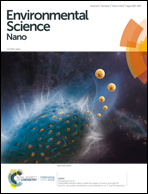Application of external voltage for fouling mitigation from graphene oxide, reduced graphene oxide and molybdenum disulfide functionalized surfaces†
Abstract
Fouling of surfaces remains one of the largest challenges in the field of water filtration. Electrically conductive surfaces have shown antifouling capabilities under organic foulants. Additionally, two-dimensional nanomaterials—e.g., graphene oxide (GO), reduced graphene oxide (rGO) and molybdenum disulfide (MoS2)—have antifouling properties and can be used to modify conductive polymer surfaces for the mitigation of fouling. Here, the surface attachment of foulants was investigated as a function of the surface charge by applying an external voltage. The release behavior of deposited foulants from polypyrrole surfaces modified with GO (GO-PPy), rGO-2h (rGO-PPy) and MoS2 (MoS2-PPy) was also studied. An electrochemical quartz crystal microbalance with dissipation monitoring (EQCM-D) was used for attachment and release studies of the foulants during external voltage application. Bovine serum albumin (BSA) was used as a model protein foulant in this study. Results show that it was possible to delay the attachment of the BSA foulant (more than 75%) on rGO-PPy and MoS2-PPy surfaces upon the application of −0.5 VAg/AgCl due to the electrostatic repulsion created by the external negative voltage on the surface. Moreover, the BSA attachment rate slows down by 92% and 91% on the rGO-PPy and MoS2-PPy surfaces compared to the bare PPy surface under the no voltage condition. Conversely, applying a voltage of +0.5 VAg/AgCl was not effective in delaying the attachment of BSA due to the presence of positively charged areas on the BSA surface. During the release study, it was found that it is possible to release the deposited BSA from all of the surfaces by NaCl electrolysis upon application of a voltage of +0.74 VAg/AgCl. Continuous generation of free chlorine (HOCl and OCl−) due to the oxidizing current produced on PPy and functionalized surfaces during external voltage application accelerates the degradation of the deposited BSA, resulting in the release of the foulant from the surface.



 Please wait while we load your content...
Please wait while we load your content...